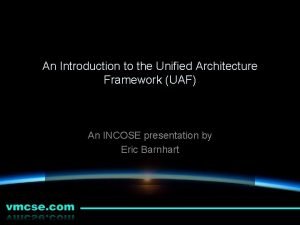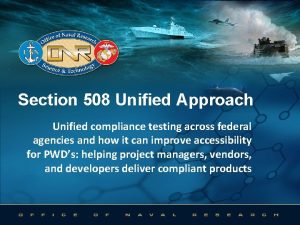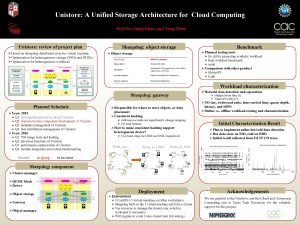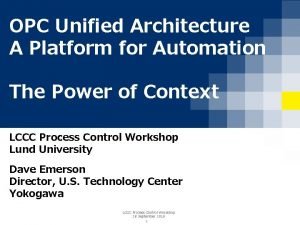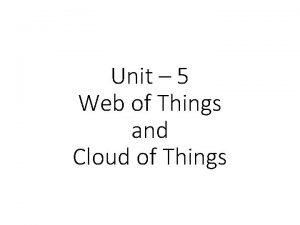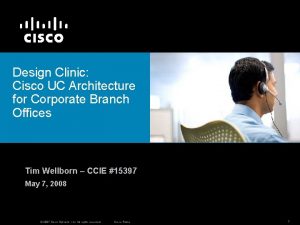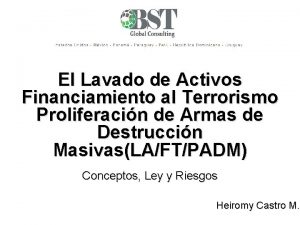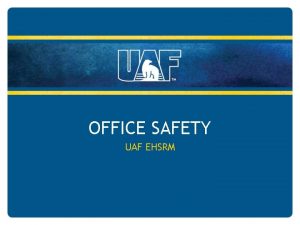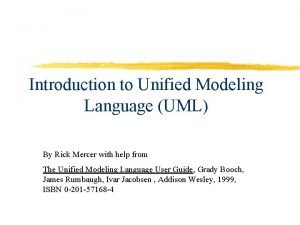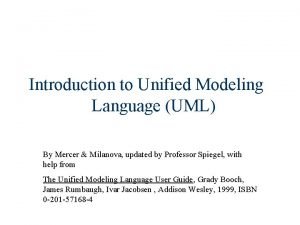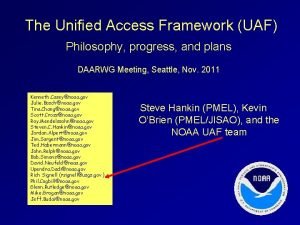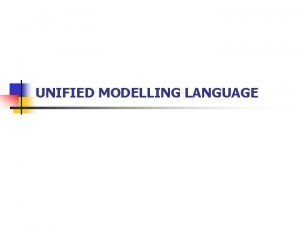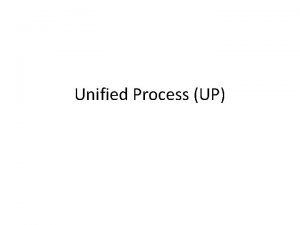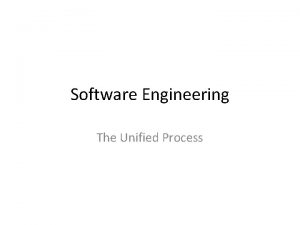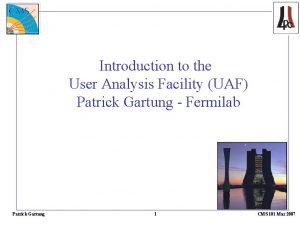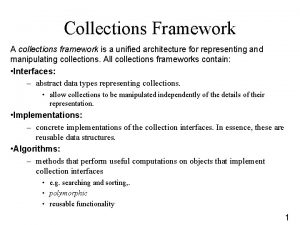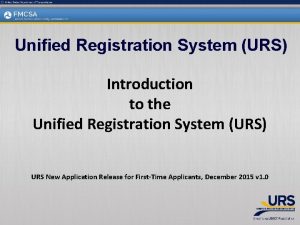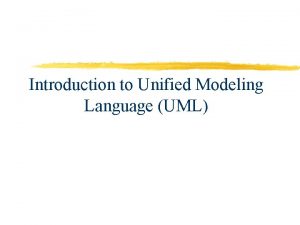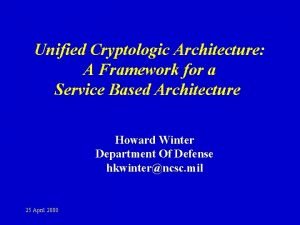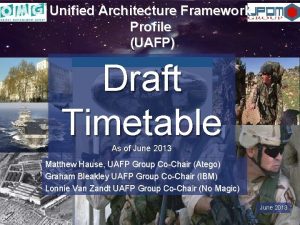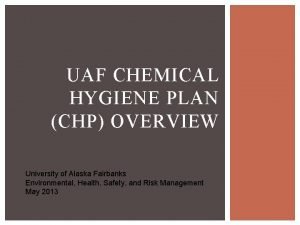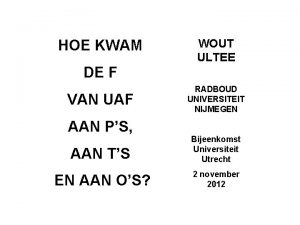An Introduction to the Unified Architecture Framework UAF
























- Slides: 24

An Introduction to the Unified Architecture Framework (UAF) An INCOSE presentation by Eric Barnhart

Introduction “Have you ever gone to Do. DAF class and left more confused than when you went in? ” “Now try going to a UAF class!”

What is UAF? • Quick answer: – UAF is the next generation of the Unified Profile for Do. DAF and Mo. DAF (UPDM) – At one time referred to as UPDM 3 • Longer Answer: – An enterprise architecture framework – Applicable for domains similar to Do. DAF, Mo. DAF and NAF (NATO Architecture Framework) – Flexible enough for non-defense domains – Implemented as a UML profile on top of Sys. ML • Realistic answer: – A complicated framework that makes enterprise architecture even harder

What is UAF Good For? • Provides a framework for enterprise analysis – Common terminology across domains – Common concepts and models – Everybody speaks the same language • Unifies the terminology across multiple frameworks • Allows MBSE / Sys. ML implementation of the models

EA vs. MBSE Despite looking similar and having common features, these are two autos are very different things These require very different mindsets Enterprise Architecture and Solution Architecture / Systems Engineering look similar but require different mindsets

EA vs. MBSE • Enterprise Architecture (EA) – Strategic information asset base – Defines mission, info needed to perform the mission, technologies to perform the mission – Defines technology transition processes • Solution Architecture (SE, MBSE) – Framework or structure – Defines elements and relationships of a system that answers a problem Strategic level Mission oriented Technology and transition Answers questions Solution focused Structural elements and relationships Systems engineering-like Provides solutions

Framework Relationships Do. DAF extends United States Department of Defense Mo. DAF extends British Ministry of Defense NAF NATO Nobody is speaking the same language any more!

Framework Relationships Do. DAF Implements in Sys. ML extends Mo. DAF extends UPDM NAF Implements in Sys. ML UPDM attempted to unify models under Sys. ML / UML

Framework Relationships Implements in Sys. ML Do. DAF Implements in Sys. ML extends Mo. DAF extends UPDM Implements in Sys. ML NAF Implements in Sys. ML updates UAF continues the effort and modernizes the framework

IDEAS Model In Do. DAF 2, understanding this conceptual model made everything much easier. UAF retains this model, but 1) changes terminology and 2) adds many new concepts

Significant Changes in UAF • • Personnel (enhanced) Project Strategy (new) Security (new!) Services (enhanced) Standards (enhanced) Nodes (gone!) Actual Resources – better support for instances versus classes / blocks

Two level taxonomy • UAF provides a better model taxonomy than UPDM • Level 1 – – – – Actual_Resources Dictionary Metadata Operational Parameters Personnel Project Resources Security Services Standards Strategic Summary_and_Overview • Level 2 – – – – – Connectivity Constraints Information Interaction_Scenarios Processes Roadmap States Structure Taxonomy Traceability This leads to the view matrix…

St-Sr St-Cn Operational Op-Tx Op-Sr Op-Cn Op-Pr Op-St Op-Is Op-Ct Services Sv-Tx Sv-Sr Sv-Cn Sv-Pr Sv-St Sv-Is Personnel Pr-Tx Pr-Sr Pr-Cn Pr-Pr Pr-St Pr-Is Resources Rs-Tx Rs-Sr Rs-Cn Rs-Pr Rs-St Rs-Is Security Sc-Tx Sc-Sr Sc-Cn Sc-Pr Projects Pj-Tx Pj-Sr Pr-Cn Standards Sd-Tx Sd-Sr Actual Resources Ar-Sr Ar-Cn Md-Ct Environment & Measurements St-Ct Data Models St-St A better taxonomy provides more logic and order to the set of views available in UAF Traceability Tr St-Tx Roadmap Rm Strategic Constraints Ct Md-Pr Parameters Pm Md-Cn Information If Md-Sr Interaction Scenarios Is Processes Pr Md-Tx States St Connectivity Cn Metadata Taxonomy Tx Structure Sr View Matrix Md-Tr St-Rm St-Tr Sv-Ct Sv-Rm Sv-Tr Pr-Ct Pr-Rm Pr-Tr Rs-Ct Rs-Rm Rs-Tr Pj-Rm Pj-Tr Sd-Rm Sd-Tr Sc-Ct

Viewing Information in UAF • Example: suppose you want to look at Operational Information for your problem domain • UAF provides view definitions for: – – – – Operational taxonomy (Op-Tx) Operational structure (Op-Sr) Numbered views (OV-1, OV-2, OV -5 etc) are replaced with more Operational connectivity (Op-Cn) meaningful and consistent views Operational processes (Op-Pr) Operational states (Op-St) Operational interaction scenarios (Op-Is) Operational constraints (Op-Ct) • Choose what makes sense for your needs • Pattern is replicated across entities as appropriate

Data Mining the Profile • The draft UAF profile is ready for use at OMG. org – http: //www. omg. org/spec/UAF/1. 0/Beta 1/ • Here’s the catch… – The profile is missing a version statement in the opening XMI line; add one and it loads properly in Rhapsody – The profile does NOT include tool-specific customizations • No menu selections • No contextual help • No error checking • Examine the profile in your tool of choice to find all sorts of cool information – Here’s an Excel spreadsheet: http: //bit. ly/2 q. CEMKG-vmcse-uaf

Sample Definitions UAF: : Operational: : Structure Operational. Agent Operational. Role Operational. Architecture Known. Resource Operational. Performer Problem. Domain Operational. Port Operational. Method Operational. Parameter An abstract element grouping Logical. Architecture and Operational. Performer. Usage of a Operational. Performer or Operational. Architecture in the context of another Operational. Performer or Operational. Architecture. Creates a whole-part relationship. An element used to denote a model of the Architecture, described from the Operational perspective. Asserts that a known Resource. Performer plays a part in the Logical. Architecture. A logical agent that Is. Capable. To. Perform Operational. Activities which produce, consume and process Resources. A property associated with a logical architecture, used to specify the scope of the problem. Usage of a Operational. Performer or Logical. Architecture in the context of another Operational. Performer or Logical. Architecture. Creates a wholepart relationship. A behavioral feature of a Operational. Performer whose behavior is specified in an Operational. Activity. An element that represents inputs and outputs of an Operational. Activity. It is typed by an Operational. Exchange. Item.

Looking at the Views • Most UAF documentation still refers to Do. DAF view identification – It’s unclear if Do. DAF nomenclature is obsolete or not – UAF spec from OMG does not use the Do. DAF view names

Operational View OV-1 is like an Op-Sr Operational Structure The elements are now <<operational performers>> From: Do. DAF V 2. 0 Community Update Overview 12 August 2010 MR. MICHAEL WAYSON; Architecture and Infrastructure Directorate; Office of the Do. D Deputy Chief Information Officer

Capabilities CV-1 is like an St-Sr Strategic Structure <<Enterprise Goal>> Increase Effectiveness of SAR Operations <<Enterprise Goal>> Improve Location Accuracy Reduce Response Time <<Capability>> Locate Source of Signal Transit Resources to Source Provide Assistance <<Measure>> Location Accuracy Time

Capabilities CV-2 is like an St-Tx Strategic Taxonomy <<Capability>> Transit Resources to Search Area <<Capability>> Calculate Distance <<Capability>> Determine Resources Required <<Capability>> Evaluate Weather <<Capability>> Evaluate Environment <<Capability>> Check Resource Availability <<Capability>> Assign Crew

Operational Views OV-2 is like an Op-Cn Operational Connectivity Satellite Status <<System>> GOES Satellite <<Organization>> NOAA k Do GR B wn lin Satellite Status k Coast Guard Search Directives Status Do. D Dis Sig tress nal lin n ow D <<Organization Performer>> <<Organization>> D Sig istre na ss l Aid <<Resource Performer>> Emergency Response Beacon <<person>> Distressed Person

Personnel OV-4 is like an Pr-Sr Personnel Structure <<Responsibility>> Delegates Commandant <<Responsibility>> Vice Commandant Commands <<Responsibility>> Commander Atlantic Area <<Responsibility>> Chief of Staff <<Responsibility>> Commander Pacific Area Commands <<Organization>> Human Resources Intel & Criminal Investigations Operations <<Organization>> C 4 &IT <<Organization>> Plans & Policy Resources

Operational OV-5 b is like an Op-Pr Operational Processes <<Operational. Activity>> Activate Distress Beacon <<Operational. Activity>> Receive Distress Beacon <<Operational. Activity>> Relay Downlink to CG <<Operational. Activity>> Assess Emergency <<Operational. Activity>> Dispatch Team <<Operational. Activity>> Render Aid <<Operational. Activity>> Transport

Summary • UAF is the next step in standardized architectures • Use of UAF vs Do. DAF nomenclature does not appear to be resolved • UAF views are better organized than Do. DAF views • UAF views are NOT much different from Do. DAF views • UAF has a long and shallow learning curve – expect slow adoption
 Updm vs uaf
Updm vs uaf Dhs trusted tester certification
Dhs trusted tester certification Unified storage architecture
Unified storage architecture Unified storage architecture
Unified storage architecture Open platform communications unified architecture
Open platform communications unified architecture Two pillars of web of things
Two pillars of web of things Processing model
Processing model Uaf ehsrm
Uaf ehsrm Concur ua
Concur ua Lms1 uaf
Lms1 uaf University of alaska fairbanks bookstore
University of alaska fairbanks bookstore Funciones de la uaf
Funciones de la uaf Uaf thesis format
Uaf thesis format Uaf admissions office
Uaf admissions office Uaf ehsrm
Uaf ehsrm üaf
üaf Introduction to the unified modeling language
Introduction to the unified modeling language Introduction to unified modeling language
Introduction to unified modeling language Introduction to unified modeling language
Introduction to unified modeling language Dispositional framework vs regulatory framework
Dispositional framework vs regulatory framework Theoretical and conceptual framework in research example
Theoretical and conceptual framework in research example Conceptual research examples
Conceptual research examples Theoretical framework
Theoretical framework Dispositional framework vs regulatory framework
Dispositional framework vs regulatory framework Conceptual framework vs theoretical framework
Conceptual framework vs theoretical framework
